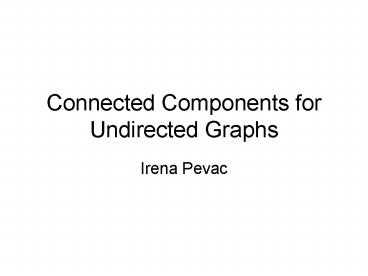Connected Components for Undirected Graphs PowerPoint PPT Presentation
1 / 20
Title: Connected Components for Undirected Graphs
1
Connected Components for Undirected Graphs
- Irena Pevac
2
Connected Components
- Def Connected component of an undirected graph
is a subgraph such that any two vertices within
it are connected with a path. - Relation P is defined as uPv iff u is connected
with a path to v. - P is an equivalence relation.
- P is reflexive For every node u uPu
- P is symmetric For every two nodes u,v
uPvgtvPu - P is transitive For every three nodes u,v,w
- uPv AND vPw gt uPw
3
Equivalence Relation P
- Equivalence relation P partitions the set of
vertices into equivalence classes. - The class containing node u is the set of all
nodes v uPv. - Example G(V,E) V 1,2,3,4,5,67,8,9
- E1,2, 2,4, 2,6, 4,6, 3,5, 3,9,
5,9, 7,8 - G has 3 connected components.
4
Find Connected Components
- Initially, all nine nodes are in components of
their own. - If u and v are in the same component Gi then Gi1
has the same set of connected components as Gi - If u and v are in different components, we merge
the components containing u and v to get
connected components for Gi1. Whenever we merge
two trees, the root of a lesser child becomes a
child of the root with greater height.
5
(No Transcript)
6
(No Transcript)
7
Running Time for Connected Components
- Let graph G(V,E)
- Let V n, and m be the greater of the number
of edges and the number of nodes. - The policy of merging lower trees into higher
ones guarantees that path from any node to its
root is less than log n. - Total time is O(m log n).
8
Minimal Spanning Tree
- A spanning tree for an undirected graph G is all
the nodes of G together with a subset of edges of
G such that - There is a path between any two nodes using only
the edges in the spanning tree. - There are no cycles. (It forms an unrooted
unordered tree.) - A minimal spanning tree is a spanning tree with
minimal sum of edges labels.
9
Applications
- Find the cheapest way to connect
- a set of cities by roads
- A set of terminals by wires
- A set of computers by telephone lines
- One undirected connected weighted (labeled)
graph can have more that one minimal spanning
tree.
10
Kruskals Algorithm
- Kruskals Algorithm for finding minimal spanning
tree is slight modification of the algorithm to
find connected components - At the beginning each node is in its own
component. - We consider the edges in the order of their
labels. (smallest label first) - If an edge has its ends in different components
we select that edge for the spanning tree and
merge components. Otherwise , we do not select
that edge for the spanning tree.
11
Graph G(V,E)
12
Edges Ordered by Weight
- Select edge B D
- Select edge C D
- Select edge D F
- Select edge A B
- Do not select edge B C
- Select D E
- Do not select C F
- Do not select E F
13
Graph G(V,E)
14
Select A B
15
Select C D
16
Select D F
17
Select A B
18
Resulting Minimal Spanning Tree
19
Greedy Algorithm
- Kruskals algorithm is an example of a greedy
algorithm. - In a greedy algorithm we make series of
decisions, each one doing what seems best at the
time. - The local decisions are which edge to add to the
spanning tree being formed. We pick up edge with
the least label that does not violate the
definition of the spanning tree. - In this algorithm local optimum is also globally
optimal.
20
Running Time for Kruskals Algorithm
- Let graph G(V,E)
- Let V n, and m be the greater of the number
of edges and the number of nodes. (Typically, the
number of edges is larger.) - If graph is represented with adjacency lists, we
can find edges in O(m) time. - To sort edges we need at least O(m log m) time.
- To do the algorithm we need O(m logn) time.
- Overall time is O( m(lognlogm) )
- Since mltn2 (there are at most n(n-1) /2 edges)
it follows log m lt2 log n gt m(lognlogm) lt
3mlogn - So, time for Kruskal algorithm is O(m logn).

